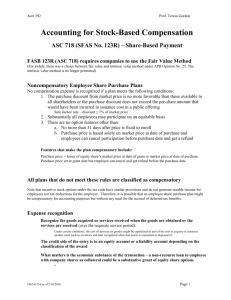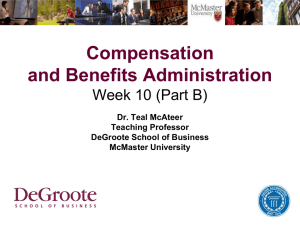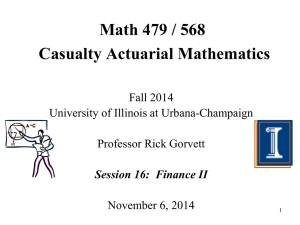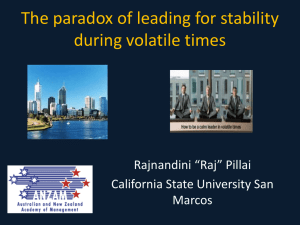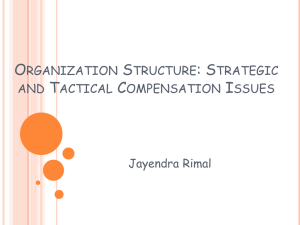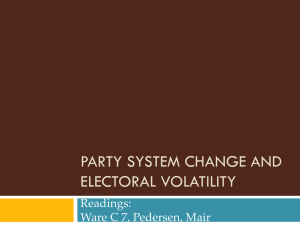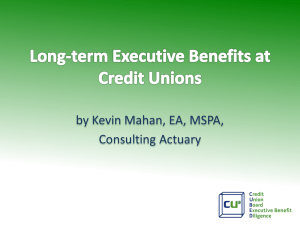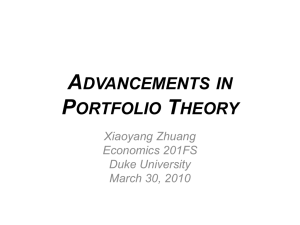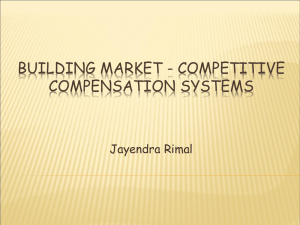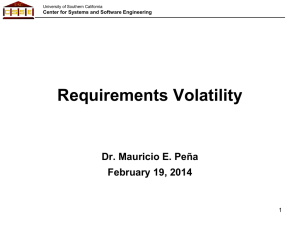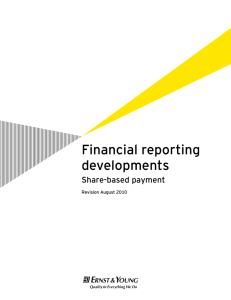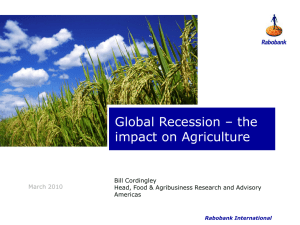1 - Mercer Capital
advertisement
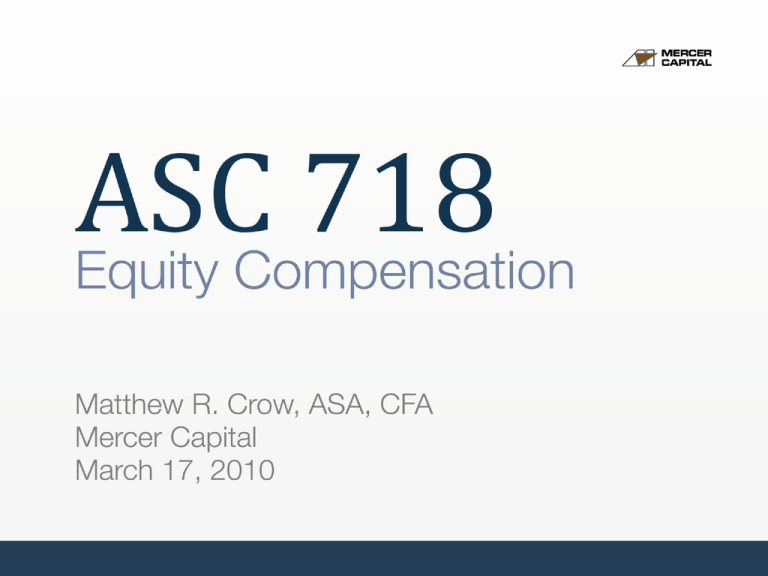
1 ASC 718: Equity Compensation CPE March 17, 2010 2 Agenda 1 Overview 2 Fair Value Measurement 3 4 Case Study Disclosure Equity Compensation Overview 3 4 Overview of ASC 718 » Measure or estimate fair value of share-based compensation at grant date » Record expense as services are received (over requisite service period) Recognition Principle 5 » Recognize compensation expense as the employee services are received with corresponding increase in equity or liability » Recognize cost as services are consumed 6 Grant Date As a “practical accommodation”, grant date is generally presumed to be the date share-based awards are approved Equity vs. Liability Classification 7 » Some instruments granted as equity compensation are reported as liabilities, rather than equity, on the issuing company’s balance sheet » Specific rules are complex and beyond our scope today. In general, if the issuing company is (or can be) required to settle the obligation with cash, rather than the issuance of stock, the instrument will be classified as a liability Stock Options: Equity Stock Appreciation Rights: Liability 8 Fair Value Based » Equity compensation cost is generally measured based on the fair value of instruments issued » Sometimes “calculated value” or “intrinsic value” Fair Value 9 » For most applications fair value is defined in ASC Topic 820; not for accounting for equity compensation » Under Topic 718, fair value is defined as: “The amount at which an asset (or liability) could be bought (or incurred) or sold (or settled) in a current transaction between willing parties, that is, other than in a forced or liquidation sale.” Requisite Service Period 10 » The period or periods during which an employee is required to provide service in exchange for the award Service condition only: typically the vesting period » Types of requisite service periods Explicit service period: stated in terms of share-based award Implicit service period: not stated, but may be inferred from terms of share-based award Derived service period: for awards with market conditions, inferred by application of valuation techniques Measurement Objective » Estimate fair value at the grant date of equity instruments the entity is obligated to issue once employees have 1) rendered requisite services and 2) satisfied any other conditions » Estimate is based on inputs at the grant date 11 Vesting vs. Nontransferability 12 » Restrictions that continue after instruments have been issued to employee (or vested) are considered in fair value measurement » Example: Restrictions on transfer of vested options or sale of vested shares (e.g., Restricted Stock) Forfeitability 13 » Restrictions related to forfeitability of unearned (unvested) instruments are not reflected in fair value estimate at grant date » These restrictions are taken into account by only recognizing compensation cost for awards that ultimately vest » Depends on type of condition Service Conditions 14 » A condition affecting the value of the award that depends solely on an employee rendering service to the employer for the requisite service period » Example: Time-vesting schedule » Not considered in measuring grant date fair value Performance Conditions 15 » A condition affecting the value of the award that depends on achievement of specified performance target defined by reference to employer’s operations » Example: Vesting based on EBITDA targets » Not considered in measuring grant date fair value Market Conditions » A condition affecting the value of the award that depends on the price of issuer’s shares or amount indexed to issuer’s shares » Example: Share price hurdle » Considered in measuring grant date fair value 16 Requisite Service Period » Estimate requisite service period at the grant date and accrue compensation cost over this period » Estimate should incorporate the probability that performance or service (but not market) conditions will be satisfied 17 Private Companies » Fair Value vs. Calculated Value » Primary difference is that calculated value is based on measure of historical volatility, rather than implied volatility » Similar to Level 1 vs. Level 3 inputs under ASC 820 18 Option Pricing Model Assumptions 19 » Exercise price » Expected option term (consideration of contractual term and expected exercise behavior) » Current price of underlying share » Expected volatility of underlying share price (for expected term) » Expected dividends on underlying share (for expected term) » Risk-free rate (for expected term) Application Consistency 20 » Consistency in assumptions / valuation techniques from period to period is important » Valuation technique / assumptions should not be changed unless expected to produce “better estimate of fair value” » Change in valuation technique represents change in accounting estimate for purposes of ASC Topic 250 21 Selecting Risk-free Rate U.S. entity should use implied yields currently available from the U.S. Treasury zero-coupon yield curve over the expected term of option Estimating Expected Term » Contractual Term vs. Expected Term » Employee stock options not transferable / hedgeable » Depends on model (lattice vs. closed form) » Considers the following: Vesting period Historical exercise / post-vesting employment termination behavior Expected volatility / share pricing Blackout periods / other restrictions Employee demographics (age, length of service, etc.) 22 Estimating Expected Volatility » Objective is to determine the assumption about expected volatility that marketplace participants would likely use. » Higher volatility Higher option fair value 23 Estimating Expected Volatility » Estimate of expected volatility should consider: Historical volatility over period similar to expected term Implied volatility based on publicly traded options Historical volatility of similar entities in terms of: » » » » Industry Stage of life cycle Size Financial leverage 24 Estimating Expected Dividends » Depending on model, estimate either: Yield Payments » Consider trends in historical dividends » Objective is to determine the assumption about expected dividends that marketplace participants would likely use 25 Case Study – Stock Grant with Market Conditions 26 » GrantCo approves grant of 1,000,000 shares to employees on March 17, 2010 » Before employees receive title to the shares, two vesting conditions must be met: Condition 1: The 20-trading-day average stock price must exceed certain hurdles. Once this condition is met, shares are considered outstanding and receive dividends as declared and paid Condition 2: The grantee (i) completes 15 years of continuous employment, (ii) reaches age 64, or (iii) dies or become disabled Case Study – Continued » Grant Date: 3/17/2010 » Condition 1 is a market condition, and must be incorporated into the fair value of the award » Condition 2 is a service condition, and is not reflected in the fair value of the award 27 Case Study – Continued » The market condition is not conducive to a closed-form (i.e., Black-Scholes) solution » Binomial analysis also difficult to implement (not only eventual outcome, but price path matters) 28 Case Study – Continued 29 Case Study – Resolution » Develop a simulation model that takes into account unique features of instrument, and calculate average outcome from many iterations » Inputs to model: Expected Volatility: 30% Risk-Free Rate: 4.58% Expected Dividend Yield: 0.62% » Fair Value: $6.58 per unit » Compensation Cost: $6.58 x 900,000 (number of shares expected to meet Condition 2) » Requisite Service Period: 11 years, based on census data regarding grantees 30 Disclosures 31 » Must disclose information so that financial statement users understand: Nature and terms of share-based payment arrangements (and effect on shareholders) Effect of compensation cost on the income statement Method of estimating grant date fair value Cash flow effects resulting from share-based payment arrangements Disclosures Example: Apple, Inc. 10-K 32 Questions Matthew R. Crow, ASA, CFA 901.322.9728 crowm@mercercapital.com Mercer Capital 5860 Ridgeway Center Parkway, Suite 400 Memphis, TN 38120 901.685.2120 www.mercercapital.com 33
